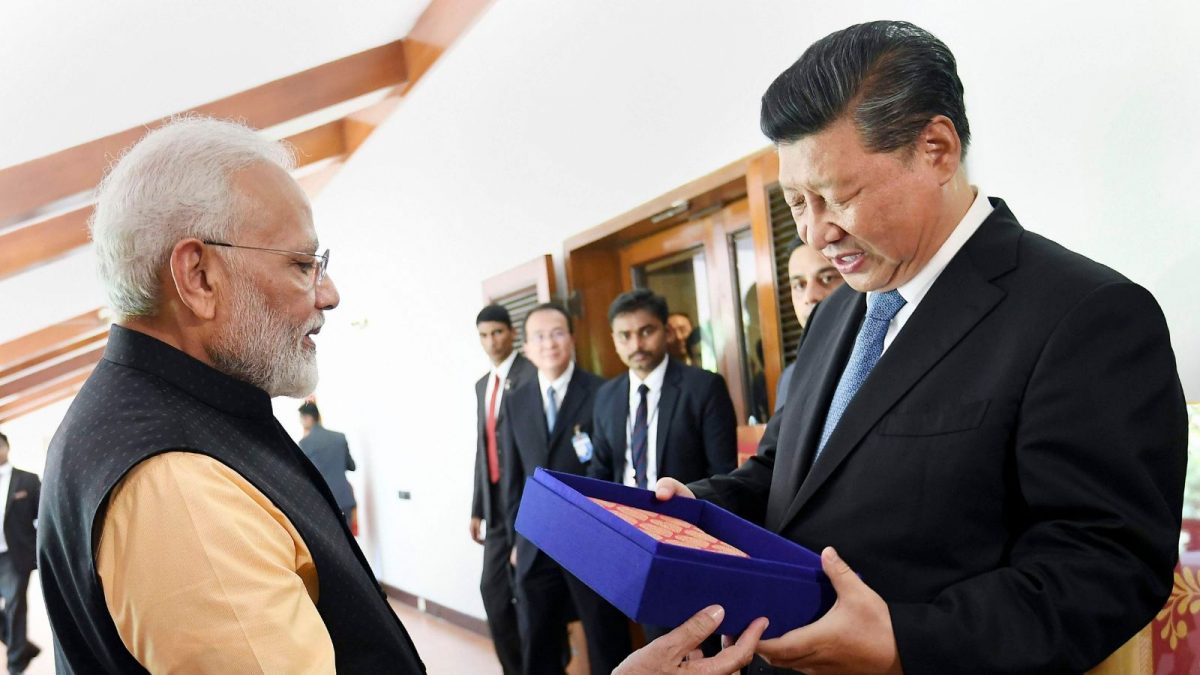Last Updated:
SCO Summit presents a high-stakes platform for PM Modi and Xi. Analysts see it as a possibility not just to defuse regional tensions but also to recalibrate diplomatic equations

Prime Minister Narendra Modi with Xi Jinping in Kovalam near Mamallapuram, in Tamil Nadu, during the Chinese President’s India visit in October 2019. (PTI File Photo)
Prime Minister Narendra Modi’s upcoming visit to China for the Shanghai Cooperation Organisation (SCO) Summit marks his first trip to the country since 2019, signalling a potential thaw in the often-fraught ties between New Delhi and Beijing.
Recommended Stories
Confirmed to take place from August 31 to September 1 in Tianjin, the summit will be presided over by Chinese President Xi Jinping and feature more than 20 leaders from across Eurasia, including Russia’s Vladimir Putin and UN Secretary-General António Guterres.
Modi, who described relations with China as having made “positive and steady” progress, accepted Xi’s invitation amid this fragile diplomatic climate. Ahead of his SCO visit, he will also attend the India-Japan Annual Summit from August 29-30, underscoring India’s strategy of multi-alignment in response to rising global tensions.
The SCO Summit presents a rare high-stakes platform for Modi and Xi to engage directly after years of border stand-offs, trade friction, and geopolitical rivalry. Analysts see it as a possibility not just to defuse regional tensions but also to recalibrate Asia’s diplomatic equations in a shifting world order.
Let us explore the India-China ties, what to expect from the SCO summit and what lies ahead.
A Return To China After Five Tumultuous Years
PM Modi’s upcoming trip to Tianjin marks his first visit to China since 2019 and, critically, since the 2020 Galwan clash that strained ties. The border confrontation left a legacy of tension, frozen direct flights, halted pilgrimages, and suspended tourism. This summit, which comes nearly half a decade later, presents a vital opportunity to rekindle dialogue and rebuild trust.
The choice of venue, an SCO summit in China, speaks volumes. The event is expected to draw over 20 leaders, including President Xi Jinping and Russia’s Vladimir Putin. More than just a gathering, it is a stage for powerful optics: solidarity, a post-Western order, and renewed ‘Shared Destiny’ messaging. Modi’s presence at the summit is not mere symbolism; it is a strategically calculated gesture.
Building Diplomatic Relations
In the months before the summit, India and China quietly laid groundwork to ease tensions. Diplomatic channels resumed. Ministerial visits, including those by National Security Advisor, Defence, and Foreign Affairs heads, paved a cautious path forward. Confidence-building measures along the border were agreed, including expert groups, direct lines, and upgraded communications to manage friction.
Beyond the Line of Actual Control (LAC), India pushed for practical cross-border easing: direct flights were reinstated, pilgrimage access to Kailash-Mansarovar resumed, and people-to-people exchanges were permitted again. Rare earth and fertilizer exports from China resumed, offering crucial import relief for Indian industry.
This is not a rosy reset. There is still a trust deficit. But the steps taken signal a mutual willingness to manage conflict pragmatically, not just ideologically.
Amid The US Trade Storm
This thaw comes amid mounting US pressure. Washington’s tariff regime and criticism of India’s energy ties with Russia, especially under Trump, have accelerated India’s push to diversify strategic relationships. China, too, confronts similar pressure. Diplomats see this as a rare triangle dance where India can reposition itself—simultaneously sending a message of strategic autonomy to the US and opening communication to Beijing without concession.
The SCO invitation, in that sense, serves as a public rebuff to unilateral Western pressure. PM Modi’s attendance signals India is not cornered, that it retains room to manoeuvre—and that the West should take note.
Security Messaging On Terrorism
Yet India is not heading to Tianjin to smile and nod. It plans to press robustly on the issue of cross-border terrorism. Defence Minister Rajnath Singh’s June refusal to sign an SCO defence statement that downplayed terrorism is fresh in memory. India has made clear that bypassing critical terror incidents, or framing the discourse in a way that avoids responsibility for terror exports, will not pass.
That firmness will likely be reinforced on the summit stage, especially with Pakistan’s representative present. India will insist on an unambiguous condemnation of terror and preserve its ground without being sidelined.
Geopolitical Advantage: SCO, BRICS, & Asian Momentum
India’s gambit extends well beyond the India–China troika. As chair of BRICS in 2026, securing China and Russia’s political buy-in is essential. SCO in Tianjin offers a prelude and platform for aligning narratives. Indeed, intangible groundwork—trust, optics, momentum—is as vital as any formal agreement.
While long-standing border disputes and scepticism remain, India is walking in not to capitulate, but to contain risk, channel dissent, and ensure this multilateral reality matters. Even symbolic steps, such as reaffirming India’s SECURE principle (Security, Economy, Connectivity, Unity, Respect, Environment), can resonate across the South Asian region amid tectonic shifts in global architecture.
A Tactical Pause, Not a Strategic Rewrite
It would be inaccurate to call this a reset. There are no sweeping breakthroughs expected. A true reset would demand resolution on core issues—Lord Brouhaha like Tibet, China’s support for Pakistan, asymmetry in trade, or radical border demarcation. None of that is on the cards.
What this visit may achieve is a tactical pause, a stabilisation in dialogue, a buffer to border flare-ups, a visual of shared governance through SCO. It signals that India is neither retreating nor recklessly expanding.
What Lies Ahead?
The SCO summit is just one moment. What follows depends on:
Follow-through: Will India and China convert dialogue into consistent military and diplomatic exchange?
Diplomatic balancing: Can India maintain engagement with China while managing ties with the US, Japan, ASEAN, and beyond?
Public narrative: Will domestic opinion tolerate too much compromise, or is messaging of strong sovereignty enough?
Ultimately, this summit could shift perceptions more than policies. It reinforces the idea that India is neither aligned nor adversarial, but actively calibrating its global posture.
About the Author

Shilpy Bisht, Deputy News Editor at News18, writes and edits national, world and business stories. She started off as a print journalist, and then transitioned to online, in her 12 years of experience. Her prev…Read More
Shilpy Bisht, Deputy News Editor at News18, writes and edits national, world and business stories. She started off as a print journalist, and then transitioned to online, in her 12 years of experience. Her prev… Read More
Loading comments…
Confirmed to take place from August 31 to September 1 in Tianjin, the summit will be presided over by Chinese President Xi Jinping and feature more than 20 leaders from across Eurasia, including Russia’s Vladimir Putin and UN Secretary-General António Guterres.
Modi, who described relations with China as having made “positive and steady” progress, accepted Xi’s invitation amid this fragile diplomatic climate. Ahead of his SCO visit, he will also attend the India-Japan Annual Summit from August 29-30, underscoring India’s strategy of multi-alignment in response to rising global tensions.
The SCO Summit presents a rare high-stakes platform for Modi and Xi to engage directly after years of border stand-offs, trade friction, and geopolitical rivalry. Analysts see it as a possibility not just to defuse regional tensions but also to recalibrate Asia’s diplomatic equations in a shifting world order.
Let us explore the India-China ties, what to expect from the SCO summit and what lies ahead.
A Return To China After Five Tumultuous Years
PM Modi’s upcoming trip to Tianjin marks his first visit to China since 2019 and, critically, since the 2020 Galwan clash that strained ties. The border confrontation left a legacy of tension, frozen direct flights, halted pilgrimages, and suspended tourism. This summit, which comes nearly half a decade later, presents a vital opportunity to rekindle dialogue and rebuild trust.
The choice of venue, an SCO summit in China, speaks volumes. The event is expected to draw over 20 leaders, including President Xi Jinping and Russia’s Vladimir Putin. More than just a gathering, it is a stage for powerful optics: solidarity, a post-Western order, and renewed ‘Shared Destiny’ messaging. Modi’s presence at the summit is not mere symbolism; it is a strategically calculated gesture.
Building Diplomatic Relations
In the months before the summit, India and China quietly laid groundwork to ease tensions. Diplomatic channels resumed. Ministerial visits, including those by National Security Advisor, Defence, and Foreign Affairs heads, paved a cautious path forward. Confidence-building measures along the border were agreed, including expert groups, direct lines, and upgraded communications to manage friction.
Beyond the Line of Actual Control (LAC), India pushed for practical cross-border easing: direct flights were reinstated, pilgrimage access to Kailash-Mansarovar resumed, and people-to-people exchanges were permitted again. Rare earth and fertilizer exports from China resumed, offering crucial import relief for Indian industry.
This is not a rosy reset. There is still a trust deficit. But the steps taken signal a mutual willingness to manage conflict pragmatically, not just ideologically.
Amid The US Trade Storm
This thaw comes amid mounting US pressure. Washington’s tariff regime and criticism of India’s energy ties with Russia, especially under Trump, have accelerated India’s push to diversify strategic relationships. China, too, confronts similar pressure. Diplomats see this as a rare triangle dance where India can reposition itself—simultaneously sending a message of strategic autonomy to the US and opening communication to Beijing without concession.
The SCO invitation, in that sense, serves as a public rebuff to unilateral Western pressure. PM Modi’s attendance signals India is not cornered, that it retains room to manoeuvre—and that the West should take note.
Security Messaging On Terrorism
Yet India is not heading to Tianjin to smile and nod. It plans to press robustly on the issue of cross-border terrorism. Defence Minister Rajnath Singh’s June refusal to sign an SCO defence statement that downplayed terrorism is fresh in memory. India has made clear that bypassing critical terror incidents, or framing the discourse in a way that avoids responsibility for terror exports, will not pass.
That firmness will likely be reinforced on the summit stage, especially with Pakistan’s representative present. India will insist on an unambiguous condemnation of terror and preserve its ground without being sidelined.
Geopolitical Advantage: SCO, BRICS, & Asian Momentum
India’s gambit extends well beyond the India–China troika. As chair of BRICS in 2026, securing China and Russia’s political buy-in is essential. SCO in Tianjin offers a prelude and platform for aligning narratives. Indeed, intangible groundwork—trust, optics, momentum—is as vital as any formal agreement.
While long-standing border disputes and scepticism remain, India is walking in not to capitulate, but to contain risk, channel dissent, and ensure this multilateral reality matters. Even symbolic steps, such as reaffirming India’s SECURE principle (Security, Economy, Connectivity, Unity, Respect, Environment), can resonate across the South Asian region amid tectonic shifts in global architecture.
A Tactical Pause, Not a Strategic Rewrite
It would be inaccurate to call this a reset. There are no sweeping breakthroughs expected. A true reset would demand resolution on core issues—Lord Brouhaha like Tibet, China’s support for Pakistan, asymmetry in trade, or radical border demarcation. None of that is on the cards.
What this visit may achieve is a tactical pause, a stabilisation in dialogue, a buffer to border flare-ups, a visual of shared governance through SCO. It signals that India is neither retreating nor recklessly expanding.
What Lies Ahead?
The SCO summit is just one moment. What follows depends on:
Follow-through: Will India and China convert dialogue into consistent military and diplomatic exchange?
Diplomatic balancing: Can India maintain engagement with China while managing ties with the US, Japan, ASEAN, and beyond?
Public narrative: Will domestic opinion tolerate too much compromise, or is messaging of strong sovereignty enough?
Ultimately, this summit could shift perceptions more than policies. It reinforces the idea that India is neither aligned nor adversarial, but actively calibrating its global posture.





